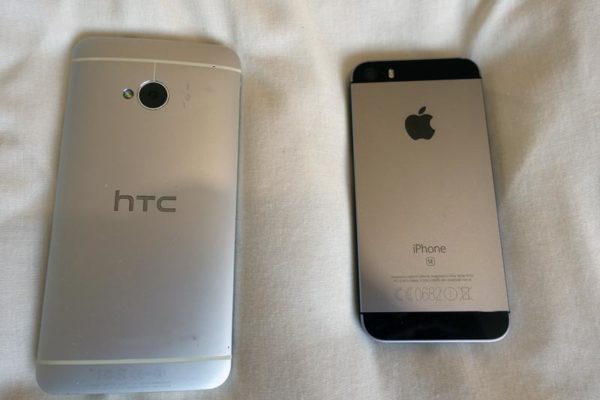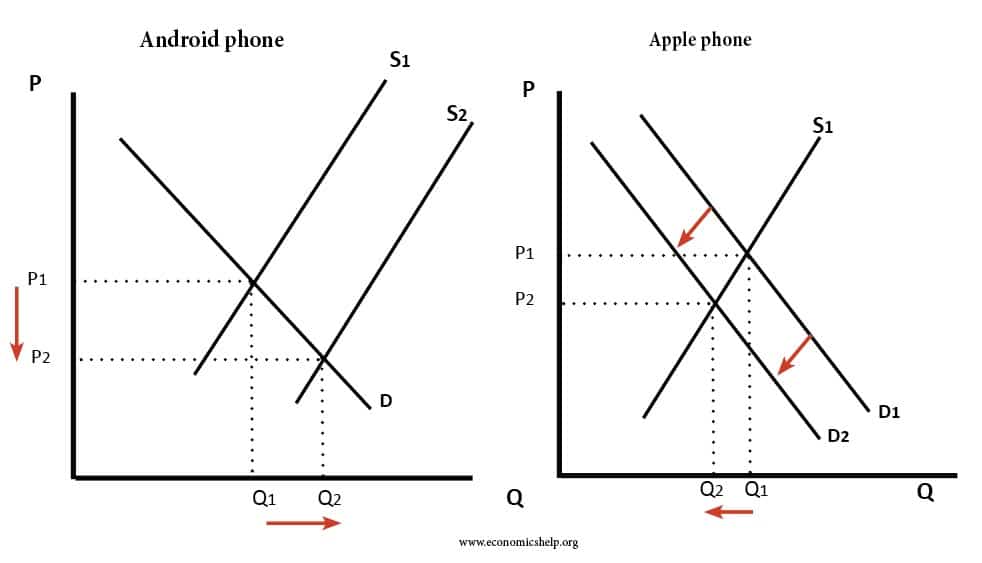Substitute goods are two goods which can be used for a similar purpose – they provide different alternatives to consumers.
In the case of Android and the iPhone, they offer similar functionality and form, but to some consumers there is a big differential in terms of brand loyalty, meaning for certain types of consumers they are very weak substitutes.
First-time consumer
Suppose your grandmother has never had a smartphone, and you persuade her to buy one. To your grandmother, the two phones will seem almost identical. For a first time user, they are more likely to focus on factors such as the price and ease of use. For this first-time consumer, the two choices will be seen as very similar and have a high cross-elasticity of demand.
Diagram showing Android and Apple as substitutes.
- If there is a fall in the price of Android Phones, consumers will demand more. (movement along the demand curve).
- As a result, there is a fall in demand for the substitute (Apple iPhone) leading to less demand. (demand curve for iPhone shifts to the left)
Suppose the typical Android phones fell in price 10%, we might expect a fall in demand for iPhones of 2%. In this case, the cross elasticity of demand for Android phones (in relation to iPhones) will be 2/10 = 0.2.
But, for the first time user, without brand loyalty the cross elasticity of demand may be higher, perhap 1.0
How important is price?
The graphs above suggest demand for Android and iPhone depend on price. However, in the real world, the price is only one factor that consumers consider. For many consumers, a phone is heavily used throughout the day. Given we can spend several hours a day, our demand for phones is quite price inelastic. We don’t look for the cheapest phone; we look for the phone which will give the best overall function. This means if we feel one phone has better features, the price becomes relatively unimportant. (good news for Apple, since their phones are often 25% more expensive)
However, if Android phones become better quality, then this may be a significant factor in encouraging consumers to switch from the iPhone to Android. In recent years, Android phones, such as Google Pixel 2 and Samsung Galaxy 8 have improved quality and diminished the gap between Android and iPhones. Now, Android phones have similar quality (retina screens e.t.c) When iPhones first came out, they were a clear market leader and so for anyone wishing to get the ‘best’ phone they were the most obvious choice. But, product development means Android users have a wider choice and Apple are losing their market position. This means they are becoming closer substitutes than in the past.
Brand loyalty
An important issue for consumers is the issue of brand loyalty. For many iPhone users there are many factors which make it likely that for their next phone, they will only consider another iPhone. For these loyal consumers, an Android is a very weak substitute. Why do existing consumers have such brand loyalty towards the iPhone?
- Compatability. If you buy a new iPhone, all the data, apps and contacts are automatically and seamlessly transferred making the purchase easy and with no time cost. If you switch from the iPhone to Android, you have to spend considerable time switching apps, contacts e.t.c. This is a big disincentive to switch.
- Complementary products. For Apple users, typically it is not just an iPhone but an Apple computer or other products, like a watch. If you switch to Android, you lose all the benefits of having complementary Apple products and seamless sharing of contacts e.t.c.
- Ease of choice. The number of phones is bewildering. When I got a new phone recently, it was hard enough choosing between different iPhone models (SE, 7,8 – I went for SE in end) I didn’t want time costs of having to weigh up all the Android models too.
- Being the first mover in the industry. The iPhone will always retain a strong brand loyalty for being perceived as the prime developer of the Smartphone. By attracting positive publicity for groundbreaking features and design, this has created strong brand loyalty which has been retained by many consumers. Apple can generate media publicity for its product launches that you never see on the same scale with Android phones.
Evaluation – will time tell a different story?
At the moment, iPhone is in a strong position because of its early dominant position. It benefits from the brand loyalty of many existing consumers. However, with technological products, brand loyalty can change over time. It is a fast-moving industry and being the first firm is no guarantee of prolonged success. Just ask IBM computers, Microsoft, Yahoo search and MySpace. With Google joining the market, Apple faces stiffer competition. Consumers may tire if they feel Apple are charging a price premium not matched by quality.
In the short-term demand tends to be price inelastic, but over time people have the opportunity to switch. Over time, demand can become more price elastic and Android may be seen as a closer substitute. For some industry watchers, the weaker enthusiasm for the launch of iPhone 8, is symptomatic of the fact, ‘peak iPhone’ may have passed. (In other words, the business life-cycle has reached peak period of growth)
Related


